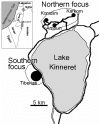Distinct transmission cycles of Leishmania tropica in 2 adjacent foci, Northern Israel
- PMID: 17326936
- PMCID: PMC3291354
- DOI: 10.3201/eid1212.060497
Distinct transmission cycles of Leishmania tropica in 2 adjacent foci, Northern Israel
Abstract
Transmission of Leishmania tropica was studied in 2 adjacent foci in Israel where vector populations differ. Only Phlebotomus sergenti was found infected with L. tropica in the southern focus; P. arabicus was the main vector in the northern focus. Rock hyraxes (Procavia capensis) were incriminated as reservoir hosts in both foci. L. tropica strains from the northern focus isolated from sand flies, cutaneous leishmaniasis cases, and rock hyraxes were antigenically similar to L. major, and strains from the southern focus were typically L. tropica. Laboratory studies showed that P. arabicus is a competent vector of L. tropica, and P. sergenti is essentially refractory to L. tropica from the northern focus. Susceptibility of P. arabicus may be mediated by O glycoproteins on the luminal surface of its midgut. The 2 foci differ with respect to parasites and vectors, but increasing peridomestic rock hyrax populations are probably responsible for emergence of cutaneous leishmaniasis in both foci.
Figures







Similar articles
-
Outbreak of cutaneous leishmaniasis in northern Israel.J Infect Dis. 2003 Oct 1;188(7):1065-73. doi: 10.1086/378204. Epub 2003 Sep 22. J Infect Dis. 2003. PMID: 14513429
-
Experimental transmission of Leishmania tropica to hyraxes (Procavia capensis) by the bite of Phlebotomus arabicus.Microbes Infect. 2006 Jun;8(7):1691-4. doi: 10.1016/j.micinf.2006.01.024. Epub 2006 Apr 21. Microbes Infect. 2006. PMID: 16815725
-
First report on isolation of Leishmania tropica from sandflies of a classical urban Cutaneous leishmaniasis focus in southern Iran.Exp Parasitol. 2010 Dec;126(4):445-50. doi: 10.1016/j.exppara.2010.05.020. Epub 2010 May 27. Exp Parasitol. 2010. PMID: 20570590
-
A review of investigations on leishmaniasis vectors in Kenya.Parassitologia. 1991 Dec;33 Suppl:453-61. Parassitologia. 1991. PMID: 1841244 Review.
-
Leishmania tropica (Kinetoplastida: Trypanosomatidae)--a perplexing parasite.Folia Parasitol (Praha). 2003 Dec;50(4):241-50. doi: 10.14411/fp.2003.042. Folia Parasitol (Praha). 2003. PMID: 14971592 Review.
Cited by
-
Promastigote secretory gel from natural and unnatural sand fly vectors exacerbate Leishmania major and Leishmania tropica cutaneous leishmaniasis in mice.Parasitology. 2019 Dec;146(14):1796-1802. doi: 10.1017/S0031182019001069. Epub 2019 Aug 29. Parasitology. 2019. PMID: 31452467 Free PMC article.
-
Phlebotomus sergenti in a cutaneous leishmaniasis focus in Azilal province (High Atlas, Morocco): molecular detection and genotyping of Leishmania tropica, and feeding behavior.PLoS Negl Trop Dis. 2015 Mar 31;9(3):e0003687. doi: 10.1371/journal.pntd.0003687. eCollection 2015 Mar. PLoS Negl Trop Dis. 2015. PMID: 25826399 Free PMC article.
-
High genome plasticity and frequent genetic exchange in Leishmania tropica isolates from Afghanistan, Iran and Syria.PLoS Negl Trop Dis. 2021 Dec 30;15(12):e0010110. doi: 10.1371/journal.pntd.0010110. eCollection 2021 Dec. PLoS Negl Trop Dis. 2021. PMID: 34968388 Free PMC article.
-
Phlebotomus (Adlerius) simici NITZULESCU, 1931: first record in Austria and phylogenetic relationship with other Adlerius species.Parasit Vectors. 2021 Jan 6;14(1):20. doi: 10.1186/s13071-020-04482-8. Parasit Vectors. 2021. PMID: 33407822 Free PMC article.
-
Salivary gland transcriptomes and proteomes of Phlebotomus tobbi and Phlebotomus sergenti, vectors of leishmaniasis.PLoS Negl Trop Dis. 2012;6(5):e1660. doi: 10.1371/journal.pntd.0001660. Epub 2012 May 22. PLoS Negl Trop Dis. 2012. PMID: 22629480 Free PMC article.
References
-
- Anis E, Leventhal A, Elkana Y, Wilamowski A, Pener H. Cutaneous leishmaniasis in Israel in the era of changing environment. Public Health Rev. 2001;29:37–47. - PubMed
-
- Schnur LF, Nasereddin A, Eisenberger CL, Jaffe CL, El Fari M, Azmi K, et al. Multifarious characterization of Leishmania tropica from a Judean desert focus, exposing intraspecific diversity and incriminating Phlebotomus sergenti as its vector. Am J Trop Med Hyg. 2004;70:364–72. - PubMed
Publication types
MeSH terms
Substances
LinkOut - more resources
Full Text Sources
